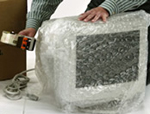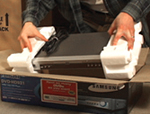Request a FREE Quote
Tips for Packing Electronics
Whether you’re a gadget fanatic, a computer nerd, a music maniac or just someone who has collected a lot of expensive electronics over the years, the idea of moving your prized electronic possessions may short-circuit your motherboard. If you’re among the 43 million Americans who will pack up and move this year, consider these tips to keep your gigabytes in working order.
Computer

This item represents a huge investment and is likely an important part of your daily life, so you want to pack it carefully. The central processing unit (CPU) should be handled with extreme care. This unit, which houses the motherboard and disk drive, is especially sensitive to jarring. Use the original carton if possible or another box large and sturdy enough to accommodate the CPU and plenty of packing materials on all sides. Packing peanuts should never be used when packing a computer because they have a tendency to carry a static electrical charge. Don’t forget to label cords and cables before unhooking them so you know where each cord goes after the move. When you arrive at your destination, allow the computer to reach room temperature before attempting to power it up.
Remember that your CD-ROMs are sensitive to heat and cold and should be moved with you rather than in a moving box. And be sure to back up all your computer files and your hard drive before disassembling the computer.
Printer
If you’re moving a laser or ink jet printer, be sure to remove the toner and any ink cartridges and carry them with you if your move occurs during hot weather. For other types of printers, the printer head should be secured to prevent shifting. Check the owner’s manual for preparations specific to your printer model.
Large-Screen Television
A large-screen TV must be custom-crated prior to moving day – which can be done arranged by a professional mover or a third-party service. Be sure to have any outside antennas disconnected and taken down if they are to be included in your shipment. Most large-screen TV owner’s manuals contain a statement that some adjustment or calibration may be necessary after transport, so make sure you refer to the manual to protect your TV in the best possible way.
Plasma and LCD Televisions
Although there are significant differences in the technology of LCD televisions and plasma televisions, the manufacturers’ recommended handling procedures are similar. It is suggested that a qualified third-party service company be used to properly prepare the LCD/plasma televisions for transport. Even with the original packaging, crating for maximum protection is recommended. When your television arrives at its new destination, it is recommended that the televisions be allowed to “set” for a period of time (several hours) before being turned on.

Other Electronics
- Determine which, if any, of these items you can live without for a few weeks and pack those first. That way, you’re not rushed and in the throes of packing the entire household and you can pay extra attention to packing these items properly.
- Whenever possible, pack electronics in their original cartons. If that’s not possible, use plenty of proper packing materials as padding. Comforters and blankets make great wraps for stereo and computer equipment, and pillows provide good cushioning.
- Clearly mark “fragile” on the outside of cartons with breakables or delicate electronics. Also mark “this side up” on items containing electronics.
- Use sturdy boxes and professional packing tape because masking tape isn’t strong enough to support fully-packed cartons. Start by padding the bottom of your box with a generous amount of packing material or padding, then wrap electronics with paper (or blankets, sheets) and place in the carton.
- If you have concerns about reassembling any of your electronics, take pictures of the fronts and backs of your current assembly so you’ve got a visual. Then mark which cords hook to which holes before taking them apart.

